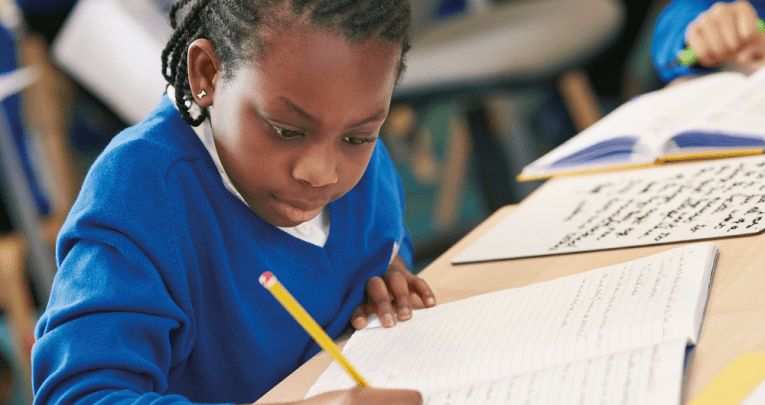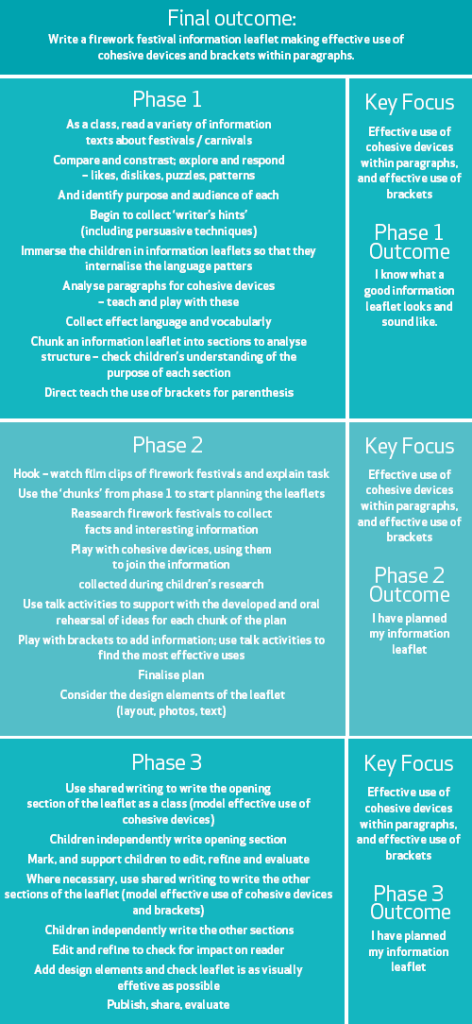Try this three-phase planning grid to embed spelling and grammar into your English curriculum

With the curriculum’s heavy emphasis on grammar, there’s a danger children could be put off writing for good. But get your planning right and there’s plenty of fun to be had, says Emma Caulfield…

I like to begin any training that I do on writing composition with the question, “What makes a book a good book?” Participants discuss their favourites and then we draw conclusions about their choices – what is it about these stories that they really love?
I often get similar responses: “It helps me to escape”; “I can really relate to the characters”; or “It’s a real page turner.”
But the point I like to make is that while the quality of the story is subjective – it depends on individual tastes – the quality of the writing is more tangible and can be judged on how well the writer communicates his or her tale, which can be hindered by elements such as poor grammar, punctuation and spelling, and by illegible handwriting.
So, what does the National Curriculum for English tell us makes writing good?
And what are the most crucial elements – the ones by which children (and teachers) will be judged? Well, there are 12 elements in the National Curriculum Interim Teacher Assessment Framework (2016) for writing at the expected standard at the end of Key Stage 1 (Standards & Testing Agency, 2015): one on expanded noun phrases for description and specification; four on grammar and punctuation; and seven on spelling and handwriting.
Similarly, in the framework for writing at the end of Key Stage 2 (Ibid), six out of nine aspects relate to spelling, handwriting and grammar and punctuation. And to be working at ‘greater depth’ at the end of KS2 children need to be able to manipulate grammatical structures, select verb forms for meaning and effect, and use the full range of punctuation.
The trouble is, spelling, grammar and punctuation can be exceptionally boring, and if children find an activity dull they will not write well. But great teachers love introducing the more technical aspects of language because they know children really enjoy discovering how these can be used to enhance their writing.
It doesn’t have to be boring
Ensuring that children are fully engaged in writing and that they understand how to use grammar and punctuation to good effect is a fine balance, but there are lots of ways to achieve this in the classroom. Here are some strategies that I’ve found work really well:
- Choose a text-type that you can have some fun with – adventure stories, spooky stories, and twists on traditional tales (ditch some of the old National Strategy narrative units!). When it comes to non-fiction, how much more enjoyable is it to write instructions for preparing a Gruffalo’s tea than brewing a common cuppa?
- Create a high-quality hook to get your children engaged in the text – just a small investment in time can result in a big pay-off. For example, scattering Gruffalo’s footsteps at the classroom entrance.
- Make sure that the children are familiar with the text-type. Read, read and read – immerse them.
- Identify the grammar and / or punctuation within a model text; discuss the job that it is doing – how is it enhancing meaning? Label it, teach it directly, and play with it. For example, play with speech punctuation by providing statements that children can punctuate using punctuation fans or finger-actions; or play with fronted adverbials by providing a sentence such as ‘John dug a hole’ and asking children to suggest appropriate fronted adverbials.
- Continue to play with grammar and punctuation. Find it in other texts, discuss its effect, and develop and extend examples.
- Use shared writing to model what you are looking for, step by step, section by section.
- Keep marking and feeding back during the whole process so that children’s writing develops as they go along.
Planning a unit that brings together all of the elements above is easy and I like to use the tried and tested ‘circles planning’ approach (around 2-3 weeks’ work depending on the age / stage of the children). This uses the Teaching Sequence for Writing from the National Strategies as its basis, and lays out the key points that should be included in each of three phases.
Phase 1:
- Immersion in text
- Shared reading
- Enjoy, explore and resond to text
- Develop comprehension skills
- Identify language / genre features
Phase 2:
- Gather ideas
- Oral rehearsal
- Plan
Phase 3
- Shared writing
- Teacher modelling
- Teacher scribing
- Supported composition
- Guided writing
- Independent writing
- Draft, revise, edit
My planner contains three empty boxes with a ‘final outcome’ box and three ‘key focus’ boxes outside of this (see the ‘Final Outcome’ table below this feature for a completed example). Once you have decided on the text that the children are going to learn to write, and identified the key areas on which you need to focus (eg, grammar, vocabulary or text structure), use these steps to plan a unit:
Step 1:
Complete the ‘final outcome’ box, eg Write an information leaflet.
Step 2:
Enter the two or three key focuses for the unit (eg Effective use of cohesive devices within paragraphs, and effective use of brackets) into all three of the ‘key focus’ boxes.
Step 3:
Add your key focuses to the ‘final outcome’ box, eg Write an information leaflet making effective use of cohesive devices within paragraphs, and effective use of brackets.
Step 4:
List the activities that will be carried out during the three phases, using the key points from the Teaching Sequence for Writing outlined above to make sure that you are covering each step.
Step 5:
Go through and slot in ‘key focus’ teaching – this should be in every phase so that there are lots of opportunities for children to practise and apply grammar, punctuation, etc. For example, in phase 1, analyse text for cohesive devices within paragraphs; teach and play with these cohesive devices.
Step 6:
Decide on the hook into writing and slot this into your plan, eg watch film clips of firework festivals.
Step 7:
Clarify audience and purpose for writing. Where will it be published?
(NB Make sure that you base your planning on the needs of the children – use your assessment information to inform the key focuses)
If we, as teachers, are bound by the National Curriculum, we should perhaps make sure that we adhere to the principles of effective writing that are laid out within it: “Effective composition involves articulating and communicating ideas, and then organising them coherently for a reader. This requires clarity, awareness of the audience, purpose and context and an increasingly wide knowledge of vocabulary and grammar.” (National Curriculum 2014,)
If we do this – and trust in what we know makes a good writer – there’s every chance our pupils will leave us not only fulfilling their potential as writers, but also enjoying writing.









